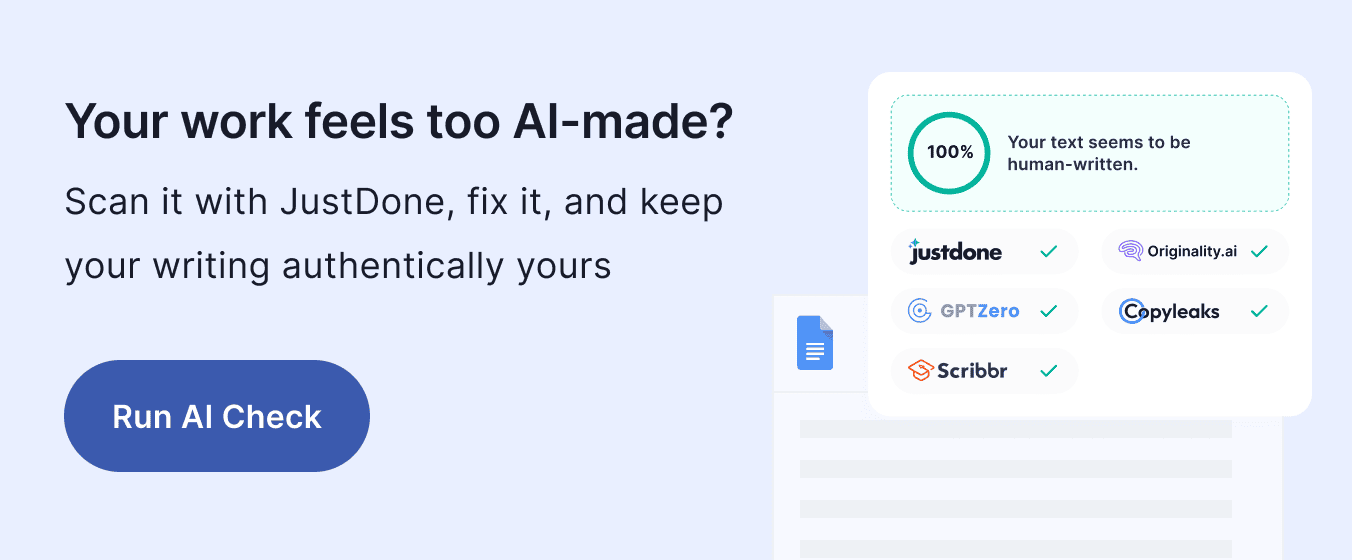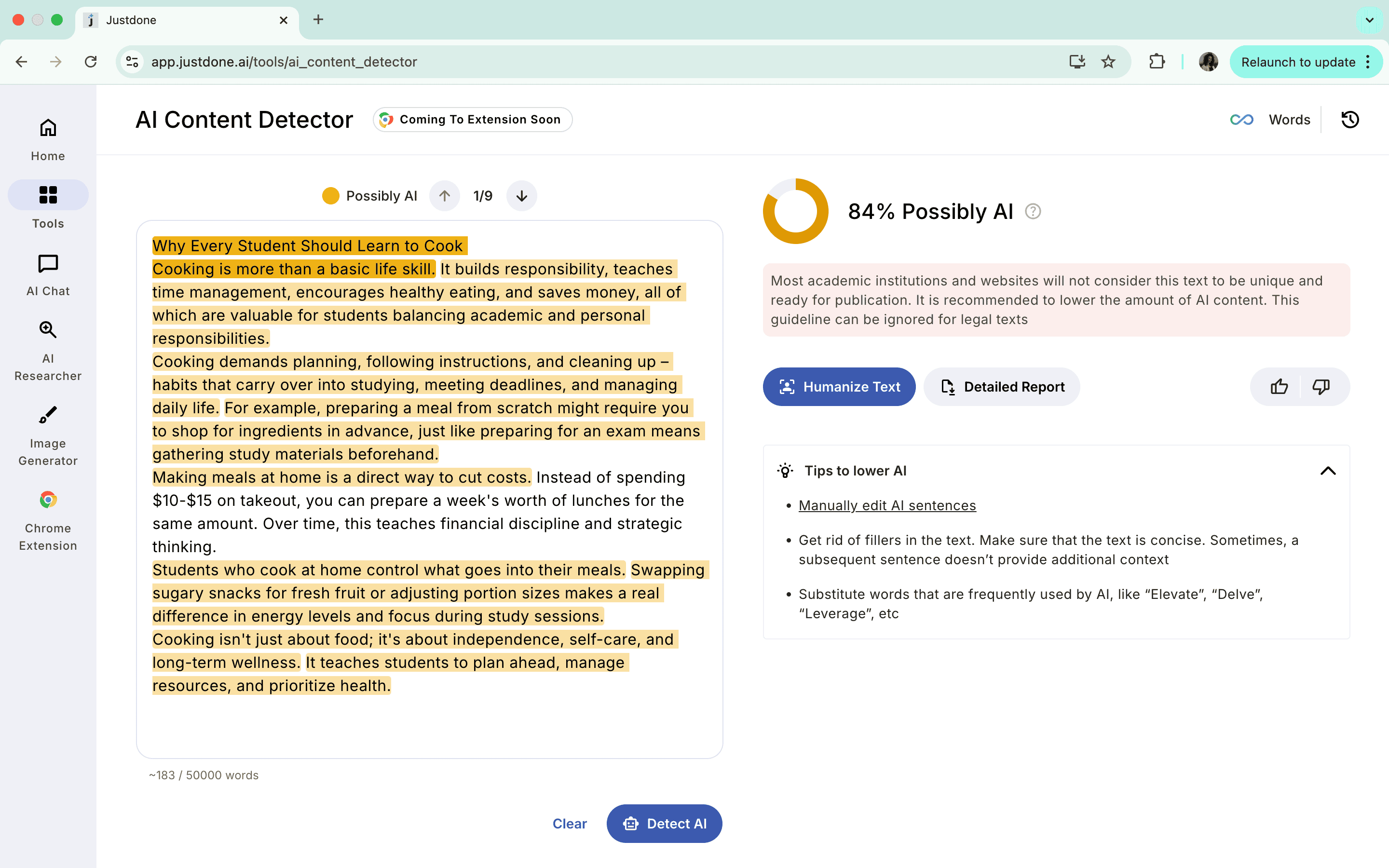What is AI score, and why does this matter? In this guide, we'll learn about AI detection scores and how AI detectors work in detail.
When running your writing through an AI detector, you get an AI detection score back – 45%, 78%, 10%, etc. What does that actually mean? What percentage of AI is acceptable? What percent of AI detection is bad?
Here's the thing: you don't need to hit some magic number to understand your AI detection score. You need the correct AI score interpretation and learn how to read the results in the right context.
Let's break it down together.

What Is an AI Score and Why Should You Care?
Your AI detection score is a metric that tells how likely your text was generated or influenced by artificial intelligence. How is it calculated? By scanning for patterns in sentence structure, vocabulary, and predictability, which are often found in AI-generated content.
However, these scores are estimates. They don't prove anything. They simply suggest that some parts of your writing resemble typical AI writing. And that's where incorrect predictions can happen: even your own original work might get flagged. Especially if you naturally write in a structured or too formal way. On the flip side, well-done AI editing could lower the score significantly.
Critical finding: Stanford study revealed that 20% of essays by non-native English speakers were wrongly flagged as AI-generated. They were compared to much lower rates for native speakers.
So before you panic, it's essential to know what your score is really telling you.
Score Interpretation: What Percentage of AI Is Acceptable?
There's no universal rule that says "X% is fine." But after working across platforms like Turnitin, GPTZero, and JustDone's AI Detector, I can give you some realistic benchmarks to work with.
| AI Score Range | Interpretation | What You Should Do |
|---|---|---|
| 0–20% | Low likelihood of AI. | Generally safe, but review anyway. Even human text can look robotic. |
| 20–50% | Mixed signals. | Review your writing voice. Edit overly formal or vague sentences. Add personal insight or specific examples. |
| 50–80% | Likely AI-generated or heavily edited. | Rewrite key sections. Make sure your work reflects your ideas and thought process. |
| 80–100% | Strong AI signature. | Avoid submitting this version. Rework content completely, or start fresh using your own words. |
What is an acceptable AI score on Turnitin?
Turnitin doesn't always give a fixed number. However, most educators say the acceptable AI score on Turnitin is below 20%. If AI detection score hits 50 percent or more, expect questions, especially if no citations or personal touches are included.
Note: Educators may interpret AI scores differently. Turnitin does not provide official thresholds.
Let's look at a comparison of the AI score calculation used in different AI detectors:
| Detector | Methodology and Score Presentation | Score Interpretation Range | Special Features |
|---|---|---|---|
| GPTZero | Analyzes perplexity & burstiness; outputs of human vs AI probability | 0-100% Probability AI-generated text | Sentence-level AI phrase highlighting, mixed content detection |
| Originality.ai | Holistic linguistic analysis; shows % of AI vs Original (human-written) texts. | 0-100% Confidence in human vs AI origin | Tailored AI/plagiarism detectors, sentence highlights |
| Turnitin | Segment-wise AI likelihood + AI paraphrasing detection | Scores under 20% marked unreliable; >20% AI likely | Combined plagiarism-AI checks, detailed flagged sections |
| Justdone | Scans sentence structure, vocabulary, predictability patterns; outputs % of AI | 0-100% Likelihood of AI-generated or influenced text | Built-in AI humanizer to help reduce AI score; flagged sentences; student-friendly interpretation with actionable feedback |
Scores vary per detector: GPTZero tends to cluster pure AI texts near 90-100%, Originality.ai covers a wide range with more confidence.
Let's compare average AI score rates per detector in detail:
| Detector | Approx. Accuracy %* | False Positive Rate | False Negative Rate |
|---|---|---|---|
| GPTZero | 80-98% | ~0-2% | ~30-35% |
| Originality.ai | 97-99% | <1% | <5% |
| Turnitin | ~86% | <1% (long texts) | ~14% (esp. hybrids) |
| Justdone AI | 95-99% | <1% | <7% |
*Accuracy percentages are estimates that vary significantly depending on text type and length.
How to Lower Your AI Detection Score Without Losing Your Work
If your AI detection score is higher than you expected, don't panic. It doesn't mean you've plagiarized; it just means your writing may look too automated. Here's what it can look like with a student's essay if you use JustDone's AI detector:

This essay shows an 84% AI detection score. While policies vary between institutions, such a high score would likely prompt additional review and discussion of your writing process and the sources you used. Remember, detectors are tools for conversation, not automatic judgment.
Based on real cases I've worked through with students, here’s what I recommend trying:
- Add personal reflection or experience. Even if it's an academic paper, inserting your own interpretation, examples, or experience can show your voice. AI usually lacks that nuance.
- Rephrase obvious, templated phrases. Sentences like "In today's fast-paced world…" or "Technology has changed our lives in many ways…" scream automation. Rewrite them to sound more like you. Find more AI words and phrases and tricks on how to replace them in my previous article about AI ethics.
- Avoid filler and wordy transitions. AI often uses overly long transitions or generic summaries. Get to the point, and vary your sentence length to sound more natural.
- Keep your sources visible. If you used AI to help summarize ideas, make sure to cite the original sources. This not only lowers suspicion but also shows academic integrity.
- Use AI Detector before submission. It highlights which parts of your text might trigger concern, so you can revise with confidence. It's a lot easier to fix a few paragraphs than to rewrite the whole thing later. Plus, JustDone offers a built-in AI Humanizer to make rewriting easier.
AI Score Meaning vs. Human Judgement
It's important to understand that an AI detection score is not a “cheating score.” It's not a final verdict. Instructors know detectors make incorrect predictions. What they want is transparency and effort.
So instead of trying to "trick" the detector, use AI editing to focus on showing your thinking and writing process. If questioned, be ready to explain how you used tools and why your submission reflects your own work.
Remember, your process matters just as much as your product.
Comparing Popular AI Detection Tools for Students
When it comes to AI detection score checking, tools differ in what they show and how you can act on it. Here's a quick breakdown of how the most common AI detection tools stack up for student use:
| Tool | What It Shows | Best For | Limitations |
|---|---|---|---|
| JustDone AI Detector | Percent AI + flagged sentences + AI humanizer built-in | Students and all others revising for authenticity | More focused on clarity than enforcement |
| Turnitin AI Writing Detector | Percent flagged as AI + section highlighting | Academic institutions checking for policy violations | Not always transparent about how the score is calculated |
| GPTZero | Sentence-level probability + per-paragraph flags | Educators scanning quickly | Less intuitive for students to use |
| Originality.ai | Detailed AI probability + plagiarism detection + sentence highlighting | Professional content review | Subscription-required, can be expensive for individuals |
If you're serious about submitting clean, original work without surprises, JustDone's AI Detector offers the clearest guidance. You're not left guessing—you're editing with direction.
AI Detection Evolution Timeline
The evolution of AI detection has been rapid and eventful and goes hand in hand with the development of AI scoring methods. Here's a brief timeline to give context to how these tools have developed and matured over the past few years:
- 2022 Early Stage: GPTZero launched as the first public AI detector. Its basic perplexity-based detection achieved approximately 70-80% accuracy. This marked the beginning of public awareness around AI-generated text detection.
- 2023 Rapid Development: Turnitin introduced AI detection in April, while OpenAI shut down its detector due to poor performance. The market saw explosive growth with multiple competing solutions emerging, reflecting a surge in both student and institutional interest.
- 2024 Maturation: Advanced multi-model systems began to dominate. Originality.ai claimed over 99% accuracy. The focus shifted toward reducing false positives and addressing bias, especially for non-native speakers and hybrid AI-human content.
- 2025 Refinement Era: AI detectors reached a new level of sophistication, since updated models offer better bias mitigation and integration of bypass detection. The market began consolidating around proven solutions with reliability and user-friendly guidance as top priorities.
You can see why AI scores may differ between detection tools and why it is critical to interpret them carefully, rather than focusing on a fixed “acceptable percentage.”
Wrapping Up on AI Detection Score
Your AI detection score is just a pattern analysis, not a judgment of your integrity. Even low scores can contain incorrect predictions, and high scores can be lowered with careful AI editing and authentic additions.
Let's sum up!
The common challenges:
- High false positives in certain writing styles, such as formal and technical.
- False negatives with hybrid and humanized AI text.
- Short texts provide insufficient context, reducing detection reliability.
- Bias concerns for non-native English speakers and neurodivergent students.
- Rapid evolution of AI generative models outpacing detector training.
- Lack of transparency in scoring and flagged segments complicates trust.
Limitations:
- Scores are probabilistic; none guarantee definitive human vs AI authorship.
- Mixed AI-human content detection remains weak.
- Reliance on language patterns can misinterpret genuine creativity or structure.
Future improvements are coming:
- Integration of multi-modal analysis (text + style + metadata).
- Enhanced adversarial robustness against paraphrasing and evasion.
- Adaptive learning with continuous AI model updates.
- More transparent scoring and explainability for users.
- Cross-checking multiple detectors for consensus scoring.
- Refinement of detection for shorter texts and non-English languages.
When you write something, ask yourself: Does this sound like something I would say? Or did I actually think this through, or just copy a suggestion? If asked, could I explain my choices? As long as you stay curious, stay honest, and use the right tools, you've got nothing to fear.